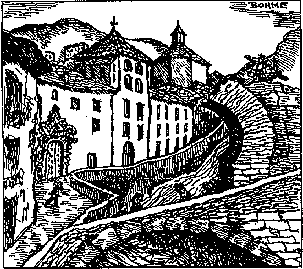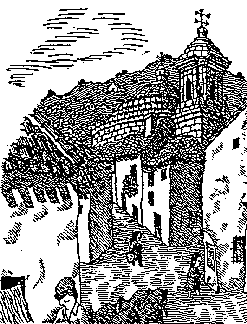 then
on it would be that romantic country to which I would travel as a
pilgrim whenever I could, and whose Mecca was Montefrio...
then
on it would be that romantic country to which I would travel as a
pilgrim whenever I could, and whose Mecca was Montefrio... I came to Spain because I wanted to study "hispanic culture", which I hopefully thought of as flamenco singing and the poetry of Lorca and Saint John of the Cross; whereas the truth was that none of those subjects had ever existed in the curriculum of the Facultad de Filosofia y Letras. Flamenco was looked down on as uncouth music for gypsies, nighthawks and left-wing intellectuals (and in retrospect I think it was better that way); Lorca, of course, was avoided as much as possible (his books, printed in Argentina, were sold but could not be displayed); and the "erotico-mistico" Saint John was totally out of line with the lofty, moralistic image of Christianity which the Franco regime promoted.
For me, after New York, the atmosphere of the university was stifling, almost medieval; my classmates were nuns, priests and - for the large part - well-off Spanish senoritas who were preparing to be school teachers, one of whom, I confess, I almost immediately fell in love with. We only studied the thinkers whose ideas were approved by the Opus Dei, a powerful Catholic organization to which most of the professors belonged. Therefore you will understand why I spent much more time in the bars around the Plaza Mayor with my friends from the student residence, and trying to get together privately with my young madrilena, than studying.
I had a great deal of trouble with the Latin, both because the Spanish students were already well advanced in this subject from their secondary studies and, also, because being a dead tongue it had no appeal for me whatsoever. A young priest in the class offered to coach me, and we spent long hours that winter in his poorly-lit flat hunched around the mesa de camilla, a round table with a brazier of smouldering embers underneath, roasting the lower parts of our bodies and trying to warm the frozen upper ones (the parts which couldn't be covered with the heavy manta or tablecloth) with the thimblefuls of brandy served by his old mother. But Joaquin's kind help would not have been enough to save me from being flunked out of the course, even if I had stayed on to take the exams.
I spent my Christmas holidays with Yves, my companion of the summer's adventures, in a picturesque garret "under the roof" of a dingy old building in the 11th arrondissement of the "ville lumiere". It was my first visit to France and by time I said au revoir to his working class family, I realized that, to paraphrase Josephine Baker, in my life there would be two loves, Spain and Paris.
Back in my apartment near the Paseo del Prado (for I had soon moved out of the uncomfortable student residence) I began to realize my error. Madrid was really just another hard, grey - and soulless - city; the mysterious Pilar, although lovelier than my Greenwich Village girlfriends, was also much less adventurous; and as for my studies, it was pretty clear that all they were going to be good for was to keep my monthly allowance of 4,500 pesetas rolling in - an amount which, in those times, was enough for me to live like a "senorito", ordering tailor-made suits, taking taxis everywhere and standing my friends from the Residence to drinks when they were out of pocket, which was most of the time.
Therefore, with scarcely a thought for the academic consequences of my rash act, I transferred to the University of Granada at the beginning of the spring, in the middle of the first year of the Latin Languages degree course. (Forgive me, father, for having disappointed you thus: if Nina ever does the same to me, I'll try to be as understanding with her as you were then!)
Behind the splendour of its Moorish castle, Granada was only a small, sleepy provincial town, and the Liberal Arts School (then housed in a 19th century palace) was, from my viewpoint, even worse than what I had left in Madrid. The fact that I was the only foreign student was sensational enough for the daily newspaper to interview and photograph me in my black corduroy suit. I was asked about my love of flamenco which I defined, quite effectively I think, as el grito del hombre en la soledad, or "man crying out in his solitude"; the reporter from El Ideal also mentioned that I had a "mane of hair like a torrent of gold", which, although only moderately long by today's standards, back then was enough to create a commotion wherever I went. I chose to study Classical Arabic rather than Greek as the lesser of two evils, but the only thing I did successfully in that class was to copy the teacher's arabesques with great elegance, for which I was much praised - even though I had only the vaguest idea what I was writing.
My passing flirtation with the Spanish University did not survive the spring, and I was soon chasing after other, more exciting rainbows. At the beginning of the Semana Santa celebrations, in a tavern, I met a young German painter-ess whom I immediately recognized as a kindred spirit. That same night I took her up to the Albaicin to see the sun rise from the Plaza de San Nicolas, and, a few days later, to Montefrio to hear my new friends singing saetas, the heart-rending flamenco chants for the Easter passion. Manolo Avila was, undoubtedly, the most spiritual butcher in the history of music, which was especially apparent when he stepped out on the balcony of the gentlemen's club called the Casino, with his grey jacket and white shirt buttoned to the throat, to solemnly salute the crucified Christ - whom he in many ways resembled, and not only when he was singing.
Lilo agreed that both Montefrio and Manolo were
"unique", and after endless conversations and bottles
of wine, we decided to spend the summer in the village, and then
go together to study in Paris, I in the Sorbonne and she in the
atelier of a painter I knew of. That was how we lived then,
making it up as we went along; as for Spain, from  then
on it would be that romantic country to which I would travel as a
pilgrim whenever I could, and whose Mecca was Montefrio...
then
on it would be that romantic country to which I would travel as a
pilgrim whenever I could, and whose Mecca was Montefrio...
After hitch-hiking to France to make arrangements for the autumn, we returned to Montefrio a few months later and rented a house to stay in. It was as graceful and tall as a tower of the Generalife, the summer palace of the Alhambra, with an tico which had three small whitewashed arabesque arches in each side; there was a framed engraving of the Cristo de Moclin imbedded in its corner behind a heavy iron grill, giving the place its name of "The Corner of Jesus", and the house the name of the corner.
We had to go to Cordoba to settle the deal with the landlady, who ran a canteen for construction workers in a tenement house. There, around a table covered in white plastic and after agreeing on a monthly rental of 650 pesetas, the matriarch handed us a heavy key. The only condition was that we could not use the parlour and bedroom on the ground floor, where she kept her belongings, and where she stayed a week during the village fiestas in August.
Since we spent most of our time in the tower painting and
writing, and slept on the second floor, we found the few days of
her presence more entertaining than bothersome. She was a hefty,
extroverted woman who dressed, of course, in black, and had a
very small one-armed husband. Strangely, the villagers still
remember this amazon (who died dramatically of a stroke a few
years later in a train station in France, where she had gone to
visit an immigrant relative) by her curious nickname: La
Barranquilla. This was the result of a humorous association
between the title of a Colombian ditty one often heard on the
radio  and the fact that, before she moved to Cordoba, she
had owned a bar (hence: bar-ranquilla). But her real name (or, as
they say, her nombre de pila, her "baptismal font"
name) was Antonia, although, as usual, no one ever used it except
when addressing her personally.
and the fact that, before she moved to Cordoba, she
had owned a bar (hence: bar-ranquilla). But her real name (or, as
they say, her nombre de pila, her "baptismal font"
name) was Antonia, although, as usual, no one ever used it except
when addressing her personally.
It would be another 15 years before the village would have running water in the houses, and Lilo had to go with the women to fill her jugs and buckets at the fountain behind the house (it would have been unthinkable for me, as a man, to assist her). High up in my tower I could see the sheet of water which constantly flowed over the stones from the splashing of the jugs, and hear the constant stream of chattering produced by the vecinas as they came and went, which seemed to go on forever, as if they talked just for the pleasure of talking.
I have always wondered how Andalusian women, when they are among themselves, manage to think of so many things to say to one another, without ever really saying anything at all. Lorca captured this brilliantly in his play The House of Bernarda Alba. I sometimes even think that my own compulsive need to communicate is the reason why I feel so much at home here, thousands of miles from the northern city where I grew up, and where the people, when they step out in the cold and rain, say to one another just what they have to say, and then go about their business.